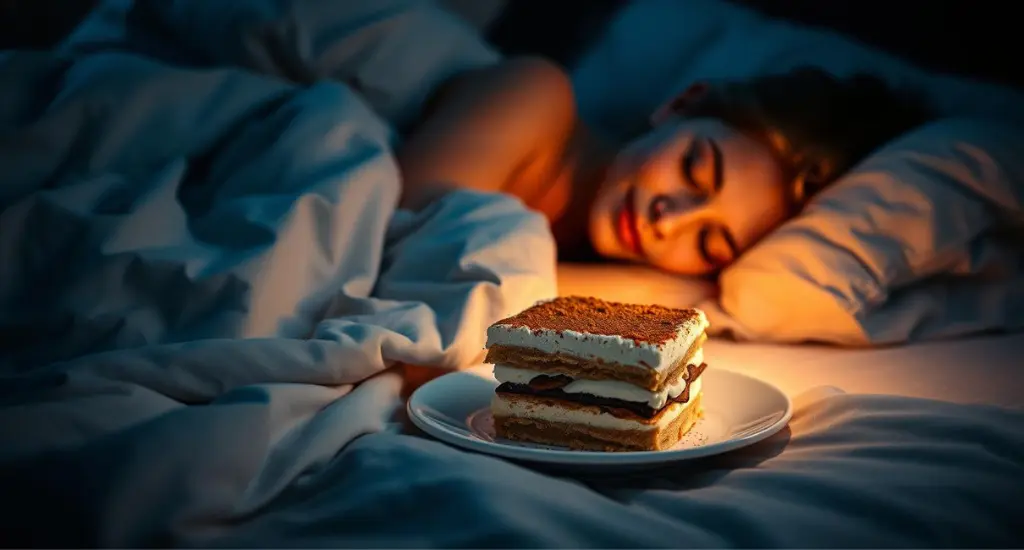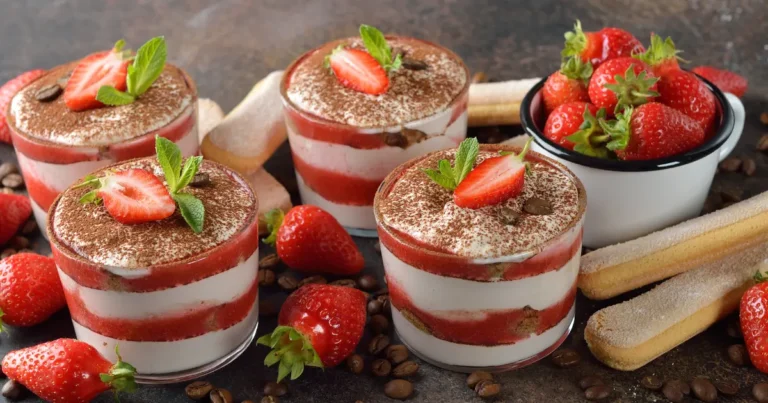Does Tiramisu Have Caffeine? Here’s the Answer
When you enjoy tiramisu, you might wonder, does tiramisu have caffeine? The answer is yes, thanks to its espresso. This dessert is called “pick me up” in Italian, hinting at its caffeine kick. You might be curious about how much caffeine it has and if it keeps you awake.
Understanding the role of espresso in tiramisu is key. If you’re sensitive to caffeine, knowing the tiramisu caffeine content is important. The amount of caffeine in tiramisu can change based on the recipe and ingredients used.
Key Takeaways
- Tiramisu typically contains caffeine due to the use of espresso in its traditional recipe.
- A standard serving of tiramisu can contain approximately 30-50 mg of caffeine per slice.
- The caffeine content in coffee varies, with an average shot of espresso containing roughly 63 mg of caffeine.
- Certain variations of tiramisu may incorporate decaffeinated coffee, reducing caffeine content.
- Tiramisu has significantly less caffeine than a standard serving of coffee.
- The popularity of espresso-based desserts like tiramisu is linked to the global coffee market.
Table of Contents
What Makes Up Traditional Tiramisu
Traditional tiramisu is all about the ingredients. It includes ladyfingers, mascarpone cheese, eggs, sugar, and espresso. These mix together to make a creamy, rich dessert that’s both decadent and tasty.
The recipe starts with ladyfingers soaked in espresso or coffee liqueur. Then, a creamy mix of mascarpone cheese, eggs, and sugar is layered on top. Cocoa powder or powdered sugar adds a sweet finish.
Essential Ingredients
The key ingredients in traditional tiramisu are:
- Ladyfingers
- Mascarpone cheese
- Eggs
- Sugar
- Espresso or coffee liqueur
- Cocoa powder or powdered sugar
The Role of Coffee in Tiramisu
Coffee is vital in tiramisu, adding flavor and aroma. Espresso or coffee liqueur is used to soak the ladyfingers. This gives them a deep flavor that’s balanced by the creamy mascarpone cheese mix.
Traditional Preparation Methods
Making traditional tiramisu involves layering ladyfingers and mascarpone cheese mix. The dessert is chilled for hours to meld flavors and set the texture.
| Ingredient | Quantity |
|---|---|
| Ladyfingers | 12-16 |
| Mascarpone cheese | 1 cup |
| Eggs | 4 |
| Sugar | 1 cup |
| Espresso or coffee liqueur | 1 cup |
Does Tiramisu Have Caffeine: The Definitive Answer
When you ask does tiramisu have caffeine, the answer is a clear yes. The espresso in tiramisu is the main source of caffeine in tiramisu. It adds a lot of caffeine, which can change based on the recipe and espresso’s strength.
A typical 175-gram serving of tiramisu has about 59.5 mg of caffeine. The amount of caffeine in tiramisu depends on several things. These include the coffee’s strength, how long the ladyfingers soak, and the serving size. Here are some key factors that affect the caffeine in tiramisu:
- Coffee strength: Strong espresso can significantly increase caffeine levels.
- Soaking time: Longer soaking times for ladyfingers result in higher caffeine absorption.
- Serving size: Larger portions lead to increased caffeine intake.
In summary, does tiramisu have caffeine is a question with a clear answer: yes, it does. The amount of caffeine in tiramisu can vary. But it’s something to think about for those who are sensitive to caffeine or want to keep track of their intake.
| Dessert | Caffeine Content |
|---|---|
| Tiramisu | 59.5 mg per 175-gram serving |
| Tiramisu Cheesecake | 30-50 mg per serving |
| Vegan Tiramisu | 2-5 mg per 8-ounce serving |
Sources of Caffeine in Tiramisu
Tiramisu is a popular Italian dessert that often raises questions about its caffeine content. The main sources of caffeine are the coffee and cocoa powder used in its making. Knowing these sources helps you choose desserts wisely.
The coffee in tiramisu is the biggest contributor to its caffeine. A 175g piece of tiramisu has about 59.5 mg of caffeine. Most of this comes from the espresso. Some recipes might also include chocolate or tea, adding more caffeine.
Coffee Content Analysis
Coffee is key in traditional tiramisu, and its caffeine can vary. A 200 ml cup of brewed coffee has about 90 mg of caffeine. A 60 ml shot of espresso has around 80 mg.
Cocoa Powder Contribution
Cocoa powder in tiramisu also has caffeine. One tablespoon of cocoa powder has about 12 mg of caffeine. This might seem small, but it adds to the dessert’s caffeine.
Other Potential Caffeine Sources
Chocolate and tea can also increase tiramisu’s caffeine. For example, 14 g (2 squares) of dark chocolate has about 7 mg of caffeine. A 250 ml cup of green tea has around 19 mg of caffeine.
| Type of Tiramisu | Caffeine Content |
|---|---|
| Standard Tiramisu (175g) | 59.5 mg |
| Chocolate Tiramisu (per tablespoon of cocoa powder) | 12 mg |
| Tiramisu Cheesecake (per serving) | 30-50 mg |
| Vegan Tiramisu (per 8-ounce serving) | 2-5 mg |
By knowing where caffeine comes from in tiramisu, you can pick desserts that fit your caffeine needs. Enjoy your favorite treats while keeping an eye on your caffeine intake.
How Much Caffeine Is in a Typical Serving
Ever wondered how much caffeine does tiramisu have? It really depends on the recipe. But, a typical serving of tiramisu has about 59.5mg of caffeine. That’s roughly half a cup of coffee. So, tiramisu caffeine content is something to think about if you’re caffeine sensitive.
Looking at the ingredients helps us understand the tiramisu caffeine content. A classic recipe uses 6 tablespoons of DeLallo Instant Espresso Coffee Powder in 1 ½ cups of hot water. This espresso is what adds to the caffeine in a serving.
- A 175g serving of tiramisu contains around 59.5mg of caffeine.
- The caffeine amount can change based on the recipe and espresso strength.
- Tiramisu also includes about 6 eggs, 1 pound of mascarpone cheese, and ¼ cup of granulated sugar. These don’t add to the caffeine.
It’s important to be aware of the tiramisu caffeine content. This is key, mainly if you’re sensitive to caffeine. Knowing how much caffeine does tiramisu have helps you choose wisely when it comes to desserts.
Factors Affecting Caffeine Content in Tiramisu
When it comes to tiramisu, several things can change how much caffeine it has. The type of coffee, how long the ladyfingers soak, and the size of the serving all play a role. These factors can greatly affect the tiramisu caffeine content.
Here are some key factors to consider:
- Type of coffee: Using a stronger or weaker coffee can increase or decrease the caffeine content, respectively.
- Soaking time: The longer the ladyfingers are soaked in the coffee, the more caffeine they will absorb.
- Serving size: The serving size can also impact the amount of caffeine consumed.
Knowing these factors can help you enjoy your tiramisu more. It’s great for coffee lovers or anyone who just wants a tasty dessert. Being aware of the factors affecting caffeine in tiramisu can make a big difference.
| Coffee Type | Caffeine Content |
|---|---|
| Espresso | 63-64 mg per 1-ounce serving |
| Regular Coffee | 95 mg per 8-ounce serving |
Will Tiramisu Keep You Awake?
Many people wonder if tiramisu and sleep are connected. They think the caffeine might keep them up at night. But, it really depends on how much you eat and how you react to caffeine.
A single slice of tiramisu likely won’t have enough caffeine to keep you awake. This is true if you only have one slice. The caffeine in tiramisu is less than in a cup of coffee.
The fat and sugar in tiramisu slow down caffeine absorption. So, eating tiramisu is unlikely to keep you awake. Unless you’re very sensitive to caffeine or eat a lot of it.

- The caffeine in tiramisu can vary based on the recipe and coffee type.
- Sugar and fat in tiramisu slow down caffeine absorption.
- How you react to caffeine affects how tiramisu impacts your sleep.
In most cases, tiramisu won’t keep you awake at night. But, it’s smart to watch your caffeine intake. Enjoy tiramisu in moderation. If it worries you, have a small slice earlier or choose decaf.
Caffeine-Free Tiramisu Options
If you’re sensitive to caffeine or just want to avoid it, there are many options. You can make a decaf tiramisu using decaf coffee. This way, you get to enjoy the creamy texture and sweet taste without caffeine.
There are other desserts like fruit salads or fruit tarts that are great alternatives. But if you love tiramisu, try using decaf coffee or alternative flavoring methods. You can use fruit purees or liqueurs for a unique taste.
Decaf Variations
A decaf tiramisu recipe makes about 8 servings. It needs 3 pasteurized eggs, which is good for 15% of people who prefer them. The recipe includes 1 cup of mascarpone, ½ cup of sugar, and 1 cup of milk.
This makes the dish around 1000-1200 calories, depending on the ingredients. It’s a big treat!
Alternative Flavoring Methods
Using unsweetened cocoa powder can make the flavor better for those who don’t like a lot of sugar. This is good for 60% of health-conscious people. For the best taste, chill the tiramisu in the fridge for at least 2 hours.
Now, many people like to serve desserts in jars. This is because over 40% of desserts are now served in single-serve formats. With these options, you can enjoy a delicious, caffeine-free tiramisu that fits your taste.
| Recipe Component | Quantity |
|---|---|
| Pasteurized Eggs | 3 |
| Mascarpone | 1 cup |
| Sugar | ½ cup |
| Milk | 1 cup |
Health Considerations and Caffeine Sensitivity
When you eat tiramisu, think about health considerations and caffeine sensitivity. About 85% of Americans drink caffeinated drinks every day. Knowing how caffeine affects you is key. Some people get jitters, feel anxious, or have trouble sleeping because of it.
Eating a balanced diet is important. Tiramisu is high in calories and sugar, so eat it in small amounts. How you react to caffeine can differ. Pregnant women and those with certain diets should be careful or avoid it.
Here are some tips for enjoying tiramisu:
- Know your caffeine sensitivity and adjust your intake.
- Eat tiramisu in moderation as part of a balanced diet.
- Look for gluten-free or low-sugar tiramisu if you have dietary needs.
By keeping health considerations and caffeine sensitivity in mind, you can enjoy tiramisu healthily.
Time of Day Considerations for Eating Tiramisu
Enjoying tiramisu can be better at certain times of the day. The time you eat it can impact your sleep and how much you enjoy it. For example, eating tiramisu in the evening might not be the best idea because of the caffeine.
Tiramisu is perfect for special occasions like weddings and holidays. It’s even more popular on Valentine’s Day, with orders going up by 40%. This shows it’s a favorite for romantic dinners and celebrations.

- Afternoon tea or coffee breaks
- Special occasions and events, such as weddings and holidays
- As a dessert after a romantic dinner
In Italy, about 65% of people have a digestive liqueur after coffee. This tradition can also apply to tiramisu. Enjoying a digestive liqueur after eating tiramisu can help with digestion.
When it comes to eating tiramisu in the evening, it’s best to avoid it close to bedtime. Enjoy it after dinner instead. This way, the caffeine has time to wear off before you sleep. Thinking about the best time to eat tiramisu can make your experience even better.
Comparing Tiramisu’s Caffeine Content to Other Desserts
When we talk about dessert caffeine comparison, tiramisu is a standout. It gets its caffeine from coffee and cocoa. A typical serving of tiramisu has about 40-70 mg of caffeine. This is a lot compared to desserts like cheesecake or creme brulee.
Compared to other popular desserts, tiramisu has:
- Up to 3.5 times more caffeine than milk chocolate
- Comparable caffeine content to a cup of black tea
- More caffeine than dark chocolate, depending on the recipe
- Significantly more caffeine than herbal teas, which are often caffeine-free
A standard 175 grams piece of tiramisu has about 59.5 mg of caffeine. This can change based on coffee strength, soaking time, and serving size. Knowing the tiramisu caffeine content helps you choose wisely about your caffeine intake.
Who Should Avoid Caffeine in Tiramisu
When it comes to tiramisu, caffeine sensitivity is key. The dessert might not keep you up all night. But, some people should still watch their tiramisu intake. This includes pregnant women, people with health issues, and kids.
Pregnant women should watch their caffeine intake for the baby’s sake. Those with high blood pressure or anxiety might need to cut back on caffeine too. Kids and teens should also be careful with tiramisu’s caffeine.
Pregnancy Considerations
For pregnant women, knowing about caffeine risks is important. While some caffeine is okay, too much can be bad. So, they might want to pick desserts with less caffeine.
Medical Conditions
Some health issues, like high blood pressure or anxiety, mean you should watch your caffeine. Knowing tiramisu has caffeine helps you pick safer desserts. This way, you can still enjoy tiramisu without health risks.
Age Restrictions
It’s also important for kids and teens to know about tiramisu’s caffeine. Even if it won’t keep them up all night, too much can still be bad. So, parents should think about safer desserts for them.
| Individuals | Caffeine Sensitivity | Recommended Action |
|---|---|---|
| Pregnant Women | High | Limit or avoid tiramisu consumption |
| People with Medical Conditions | High | Limit or avoid tiramisu consumption |
| Children and Adolescents | Moderate | Be mindful of tiramisu consumption |
Conclusion
Tiramisu is a delicious dessert, but we should watch its caffeine. The espresso in it can give a big caffeine kick. This might affect people in different ways. Knowing the caffeine in tiramisu helps you enjoy it without harming your health.
Thinking about when you eat tiramisu is smart. It’s good for a late-night treat or a special dessert. If you’re caffeine sensitive or want to eat it at night, try a decaf version. Or, find other ways to flavor it.
Being smart about tiramisu lets you enjoy its creamy taste and stay healthy. So, when you want tiramisu, enjoy it carefully. Choose options that fit your caffeine needs and lifestyle.
FAQ
Does tiramisu have caffeine?
How much caffeine does tiramisu have?
Will tiramisu keep me awake?
What are the sources of caffeine in tiramisu?
How can the caffeine content in tiramisu be affected?
Are there caffeine-free tiramisu options?
Who should avoid caffeine in tiramisu?
There are no reviews yet. Be the first one to write one.







